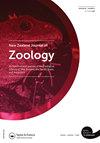rkiye爱琴海Köyceğiz泻湖中采集的auratus鲻鱼耳石形态的发育变化(Risso, 1810) (Mugiliformes, Mugilidae)
IF 1.1
4区 生物学
Q3 ZOOLOGY
引用次数: 0
摘要
摘要描述了19个特征来定义耳石的形状。这项研究的结果显示了基于记录形状的不同年龄组的个体发生变化。属于鱼类长度组GI和GII的年轻个体的耳石形状与其余七个长度组的老年个体的耳石形状不同。与其他地区已发表的金龟耳石描述比较,发现在较大的地理距离上存在种间差异,使某些特征对诊断无用。其他耳石特征在不同长度群的耳石中是一致的,这些特征可以作为物种鉴定的目的。这些特征是耳石的宽度、深度、中侧壁的形状、耳沟的形状、耳口和尾的形状以及耳尾分化的形状。我们要感谢Muğla Sıtkı科帕尔曼大学科研项目办公室(项目编号:17/119)对本研究的资助。披露声明作者未报告潜在的利益冲突。本研究由Muğla Sıtkı科本文章由计算机程序翻译,如有差异,请以英文原文为准。
The developmental changes in the morphology of the otolith of the mullet Chelon auratus (Risso, 1810) (Mugiliformes, Mugilidae) collected from Köyceğiz Lagoon, Aegean Sea, Türkiye
ABSTRACTNineteen traits were described to define the shapes of the otoliths. The outcomes of this study display ontogenetic variations for different age groups based on the recorded shapes. Otoliths of the young individuals belonging to fish length groups GI and GII have shown differences in the otolith shape from those of the older individuals of the remaining seven length groups examined. A comparison with earlier published otolith description on C. auratus collected from other areas showed some interspecific variation across larger geographic distances, making some characters useless for diagnostic purposes. Other otolith features were shown to be consistent in otoliths from different length groups and such characteristics could be considered for species identification purposes. These characteristics are otolith width, depth, shape of the mesial and the lateral surfaces, shape of the sulcus acusticus, shape of the ostium and cauda and shape of the ostio-caudal differentiation.KEYWORDS: MorphologySEMontogenyinterspecific variationotolith ornamentationsvariation AcknowledgmentsWe would like to thank Muğla Sıtkı Koçman University, Scientific Research Project Office (project number: 17/119) for funding this study.Disclosure statementNo potential conflict of interest was reported by the authors.Additional informationFundingThis study was funded by Muğla Sıtkı Koçman University, Scientific Research Project Office (project number: 17/119).
求助全文
通过发布文献求助,成功后即可免费获取论文全文。
去求助
来源期刊
CiteScore
2.80
自引率
0.00%
发文量
20
审稿时长
>12 weeks
期刊介绍:
Aims: The diversity of the fauna of the southern continents and oceans is of worldwide interest to researchers in universities, museums, and other centres. The New Zealand Journal of Zoology plays an important role in disseminating information on field-based, experimental, and theoretical research on the zoology of the region.

 求助内容:
求助内容: 应助结果提醒方式:
应助结果提醒方式:


